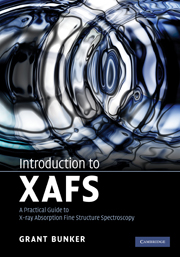Book contents
- Frontmatter
- Contents
- Preface
- 1 Introduction
- 2 Basic physics of X-ray absorption and scattering
- 3 Experimental
- 4 Theory
- 5 Data analysis
- 6 Related techniques and conclusion
- Appendix 1 Introduction to Fourier transforms in EXAFS
- Appendix 2 Cumulants in EXAFS
- Appendix 3 Optimizing X-ray filters
- Appendix 4 Reference spectra
- Appendix 5 X-ray tables
- References
- Index
Appendix 3 - Optimizing X-ray filters
Published online by Cambridge University Press: 25 January 2011
- Frontmatter
- Contents
- Preface
- 1 Introduction
- 2 Basic physics of X-ray absorption and scattering
- 3 Experimental
- 4 Theory
- 5 Data analysis
- 6 Related techniques and conclusion
- Appendix 1 Introduction to Fourier transforms in EXAFS
- Appendix 2 Cumulants in EXAFS
- Appendix 3 Optimizing X-ray filters
- Appendix 4 Reference spectra
- Appendix 5 X-ray tables
- References
- Index
Summary
Despite advances in energy dispersive detector technology, X-ray filters remain a useful tool for optimizing fluorescence XAFS experiments. They are essential when using fluorescence ionization chambers if diffractive analyzers are available.
The filter quality is an important but frequently ignored parameter that can determine the success or failure of a fluorescence XAFS experiment. In this appendix we define filter quality, describe its effects, and derive equations and rules of thumb for choosing the optimal filter thickness during an experiment. We will see that the optimal thickness depends on the background to signal ratio, the quality Q of available filters, and the effectiveness of the slits.
This appendix is concerned with minimizing high-energy (usually elastically scattered) background. Filters are used to preferentially absorb the X-rays that are scattered from dilute samples. Statistical fluctuations in the number of scattered photons are a principal source of noise in fluorescence EXAFS experiments, and it is therefore desirable to minimize the scattered background as much as possible, without attenuating the signal significantly. As described above, normally the main constituent of a filter is an element which has an absorption edge that falls between the strongest fluorescence lines and the absorption edge of the element of interest (see Figure 3.12). In many cases a suitable filter can be constructed using the element of atomic number (Z) one less than that in the sample (a “Z – 1 filter”).
- Type
- Chapter
- Information
- Introduction to XAFSA Practical Guide to X-ray Absorption Fine Structure Spectroscopy, pp. 219 - 231Publisher: Cambridge University PressPrint publication year: 2010

